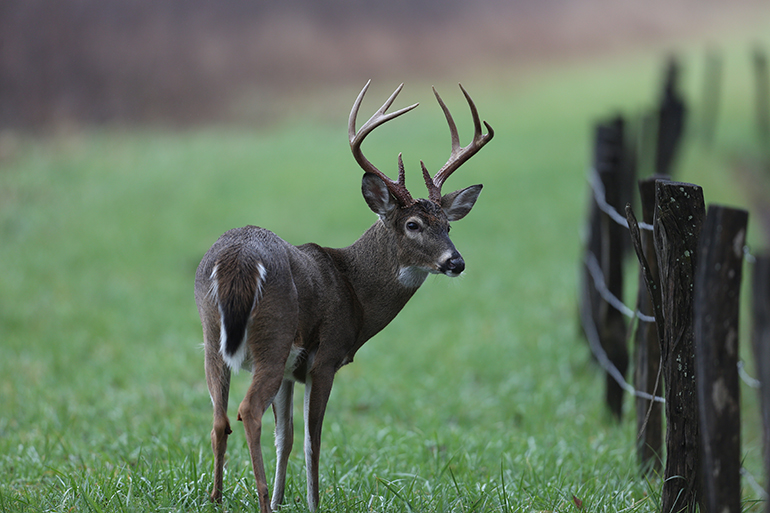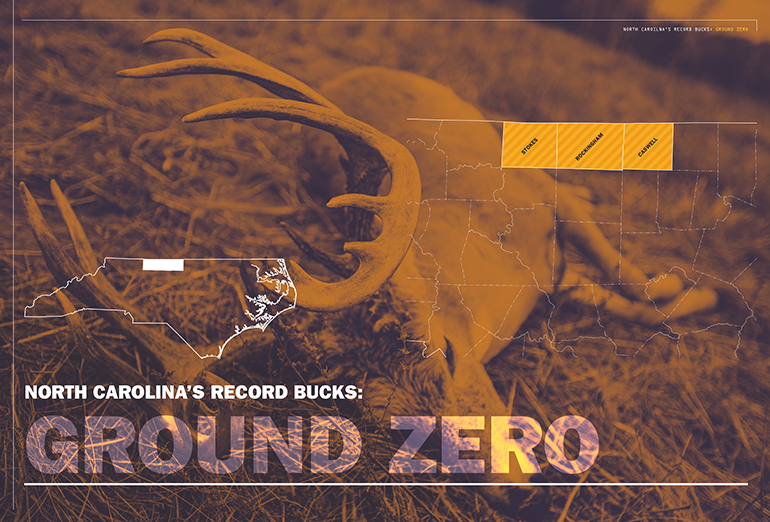
North Carolina has some giant bucks for those who know where to look for them.
North Carolina has some terrific whitetail hunting make no mistake about it. But just like anywhere else, there are “sweet spots” nestled across the state, ones you should have on your radar if looking to score a monster.
In the last five years, hunters have taken more bucks with antlers scoring high enough to make the Boone and Crockett Club’s record book in Caswell, Rockingham and Stokes counties than in other counties. While many counties along the Virginia border yield outstanding bucks, Caswell Rockingham and Stokes counties have produced more “Booners” than any others in the past five years.
Jon Shaw, the NCWRC Deer Biologist, said that while a sample consisting of record-book bucks is small, that area has several factors going for it. “Simply put, good soils are the primary reason,” Shaw said. “When soil has good nutrients, quality foods are abundant, allowing bucks to grow larger antlers, faster.”
Another reason is a perfect mix of bottomland hardwoods, agriculture, pasture and upland timber management. Nevertheless, other counties in the northern piedmont, foothills and Yadkin-Pee Dee River corridor have the same habitat.
“Age is an important factor,” he said. “Hunters in that area may use selective management and the two-buck limit probably helped. We also identified Stokes as having the ideal season. It is in the Northwestern Season, which is timed perfectly with the breeding season, it does it better than any other county. Rockingham and Caswell are in the Central Season, where the timing is also close to nearly ideal too.”
However, hunting competition is fierce here because these counties are near large cities. Fortunately, new game lands opened in Stokes County and R. Wayne Bailey-Caswell Game Land is a perennial hotspot. While Rockingham County has no public lands, hunters can find private farms to lease.

Two New Stokes County Game Lands
Two years ago, the Commission opened a new game land in Stokes County. The 156-acre Hill Farm Game Land is small, but significant, because it was the first public land in one of the state’s highest demand deer hunting areas.
Bronson Hannah is the Commission’s R. Wayne Bailey-Caswell Game Land Team Leader. He also ramrods maintenance and improvement operations at Stokes County game lands and said word is getting out, but hunting opportunities are limited.
According to Hannah, “It’s a new game land, so it hasn’t been on many hunters’ radar; it borders Dan River so it has bottomland hardwood forest. We have been doing some field management at several small fields and two large fields, planting them with annual food plots. In winter, we plant winter foods to attract deer. The surrounding property is mostly farmland, so the potential for big bucks is there. If one thing is limited, it is cover because most of the forest is mature hardwood, with little understory.”
Hill Farm Game Land is a permit-only area for deer hunting. The quota is four hunters for each hunt with a maximum party application of two hunters. Hunts are available for archery, muzzleloader and firearms seasons.
Dan River Game Land opened during the 2018-19 hunting season. It has 1,728 acres of mixed habitat. “Dan River Game Land is a peninsula with four miles of frontage along the Dan River, so it has good bottomland habitat,” Hannah said. “We plant 80 acres of fields in corn, soybeans and annual mixes that include sunflower, milo, buckwheat and cowpeas. That provides good summer forage as well as a lot of browse during archery season.”
A NCDOT paved road, Riverside Circle, runs through and around the game land and provides access to many fields. Egyptian wheat helps hide the field entrances. Timber operations are ongoing under an agreement with the previous owner. Most of the timber is pine, less than 15 years old. Some clear-cuts exist, and others will open from harvest operations. Even the hardwoods in the floodplain were subjected to high-grade harvests in the past.
“Dan River was a farm and timber operation, but was leased to a trophy management club,” Hannah said. “I personally spoke with hunters who leased the property who said the hunting was excellent.” The game land is a permit-only area for deer. The quota is eight hunters with a maximum party application of two.
R. Wayne Bailey-Caswell Game Land
R. Wayne Bailey-Caswell Game Land in Caswell County consists of 17,198 acres owned by the Commission, Duke Energy and Scouts BSA. Hannah said the biggest buck he has taken at Caswell was a 4½-year-old 8-pointer with a heavy rack.
He has worked at Caswell 14 years and said he has seen two 10-pointers taken during youth permit hunts. The Commission hosts youth and disabled permit hunts on the 500-acre shooting range area, which not open for any other hunting. Hunters have also taken big bucks at the Scout Camp, an archery only area.
“Caswell has lots of mast-producing forest,” Hannah says. “We have upland hardwoods and bottomland hardwoods. Country Line Creek is the largest and most popular bottom and it borders the restricted shooting range area. On our Tier 3 permit hunts, we assist disabled hunters, who hunt blinds overlooking plots. On our Tier 2 hunts, disabled hunters draw a blind and can hunt with the assistance of helper.
The rest of the game land is open three days per week. Hunters use many different methods to take big bucks. It is within the area of the state where hunting deer with hounds is legal, so coursing deer with dogs is popular.
Still hunters walk along the many trails and through the bottoms, quietly stalking. Much of the rolling terrain and cover is very amenable to still hunting. Stand hunting is the method most hunters prefer. They use climbing stands (portables) and lock-on stands overlooking the fields and hardwood bottoms, but a few just sit on the ground. Hannah said the best time to find a buck on the move is during the muzzleloader season, before hounds stir up the deer. “If you are after a trophy buck, you are better off staying away from the fields,” he said. “The bucks stay in the thicker cover after the gun season opens and the hunting pressure gets high.”
Biological surveys show that the average age of deer taken by hunters at Caswell is 1½ years. That is not old enough for a buck’s antlers to reach trophy size. “But, the big bucks are still there,” Hannah says. “We run cameras to monitor the feral pig population and I have seen deer with 140- and 150-class antlers on camera images. I am sure a Boone and Crockett buck is there and I will be hunting for him this fall.”
Check out this video to learn how to manage your small track of land to bag your trophy buck.
“Hunt North carolina Farm Land”
The top way of bagging a trophy buck is by hunting private property. Private farms offer excellent nutrition, resulting in super-sized antler growth. Hunting pressure is also lighter than it is on public lands.
However, competition for private hunting land is high, so leases are expensive. Finding a lease can be as difficult as finding a good spot to hunt on public land on opening day of the firearms season. However, about five years ago, as part of an initiative to bring hunters and farmers together to benefit both, the N.C. Department of Agriculture and Consumer Services launched “Hunt N.C. Farmland,” with its own tab hunters and landowners can use on the agency’s website. The genesis of the program was helping farmers who needed help in controlling deer numbers — and accommodating hunters wanting to find private property to hunt.
Hunters looking for leases, as well as landowners looking for hunters to lease their land, begin by keying Hunt N.C. Farmland into their search engine, visiting ncagr.gov/hunt or visiting the Commission’s Website, ncwildlife.org, which has a Hunt N.C. Farmland tab that links to the N.C. Department of Agriculture site.
Hunters can search for land to lease by county, species, allowable weapons and other parameters. Landowners can list amenities, such as whether the property has a cabin or clubhouse, whether the landowner needs help maintaining fields, the size and condition of the property and types of cover available.
The hunter must go through a log in process and complete an electronic form. That initiates the contact between the hunter and landowner. A recent search for the three counties found only one farm listed in Caswell County. The farm had 172 acres and the lease price was $3,000 per year for a maximum of four hunters. While that lease is likely no longer available, hunters should keep checking the website because new leases come up relatively often.
The best time to visit Hunt N.C. Farm Land is around the first of the year. Property taxes are due, and landowners often view hunting leases as a means of paying their taxes. Another good time is the mid-summer period, when hunting clubs find out whether members may be leaving, and they need to replace them or end their lease agreements with landowners.








